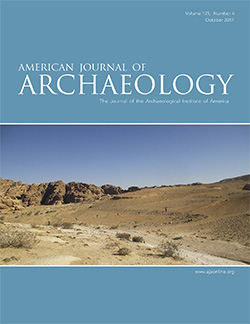AJA Open Access
BY-NCOctober 2017 (121.4)
Book Review
Catania: Archeologia e città I. Il progetto OPENCiTy: Banca Dati, GIS e WebGIS
Edited by Daniele Malfitana, Antonino Mazzaglia, and Giuseppe Cacciaguerra
Reviewed by Carlo De Domenico
OPENCiTy is an innovative public archaeology project created by the Institute for Archaeological and Monumental Heritage of the National Research Center of Catania. The project’s goal is to present historical, archaeological, archival, and topographic data for the study of Catania in an interactive online geographic information system (WebGIS). The project is designed as a tool for the functional management of cultural heritage and the evaluation of sustainable urban development, and it is addressed to research institutions and academic communities, as well as to the Superintendency for Cultural and Environmental Heritage and the public sector.
This volume includes numerous contributions by young researchers and consists of nine chapters, an appendix, and a plethora of high-resolution images (urban aerial views, plans, historical documents, and archival material). Two fundamental components of the project presented in this book, a database and a GIS, will be launched as an online resource (www.opencityproject.it/) in the near future. The volume’s chapters group into three sections: the first (chs. 1–3), descriptive in nature, presents the salient moments of the urban development of Catania; the second (chs. 4–6) is dedicated to the treatment of valuable archival documents, catalogued and digitized, and the presentation of the first results from the geophysical surveys conducted on certain sectors of the urban environment; the third (chs. 7–9), for a specialist audience, specifically analyzes the structure of the database and GIS system that form the basis of OPENCiTy.
OPENCiTy’s public and multidisciplinary nature is a good indicator of a gradual overcoming of the sectorial and professional boundaries that have characterized the study of Catania for decades and have sometimes slowed or even hindered research. One of the main aims of the project is to foster the cooperation of specialists in the field of cultural heritage, from archaeologists and geologists to computer scientists and engineers, all of whom can increase understanding through open communication and free data sharing.
The first section of the book (chs. 1–3) outlines the urban archaeology of Catania, synthesizing the city’s developmental phases and describing the reuse and repurposing of ancient monuments in the modern period. Geological and hydrological features, as well as catastrophic events, including earthquakes (1169, 1542, and 1693 C.E.) and volcanic eruptions (696/3 B.C.E., 425 B.C.E., 1381 C.E., and 1669 C.E.), that have damaged the urban fabric are also discussed. Next, some major criticisms of Catanian urban archaeology are raised, such as the limited knowledge base, the failure to publish the excavations carried out during the 20th century, the lack of awareness of the archaeological potential of the subsoil, and the illogical development of the urban fabric following speculation in the 1950s and 1960s.
The most engaging chapter, entitled “Catania Liquida,” is inspired by the first aerial photographs of the city, taken by Luigi Pirrone, a historian and collaborator of Guido Libertini, professor of classical archaeology at the University of Catania and director of the Italian Archaeological School at Athens between 1939 and 1941. A collection of colorful and previously unpublished picturesque views of the city, captured more recently by drones, are also provided here. The “liquid” view of space, described in the 1930s by the photographer, constitutes a metaphor for the continuously changing nature of the urban landscape.
The second section of the volume (chs. 4–6) discusses OPENData for Catania, a historical and archaeological digital data archive conceived as a means of research within a context of limited funds, through which it is possible to disseminate scientific results to the community. This is followed by a reexamination of the textual and iconographic documentation of the city, including historical and modern photographs, published and unpublished graphic documents, historical cartographies, and bibliographic references from the 16th century onward. Also presented in this section are the first results of the digitization and study of the collection previously belonging to the monks of the former monastery of Benedictines, now housed within the joint Municipal and A. Ursino Recupero Libraries. These print sources, dating from the 16th century to the 1860s, consist of scholarly works on Sicily, treatises on historical-archaeological research, dissertations by the Prince of Biscari on Catanian antiquity, and rare manuscripts. This archival-documentary part of the volume is followed by a technological-scientific section presenting the preliminary results of the geophysical (georadar and geoelectric) surveys conducted by the Consiglio Nazionale delle Ricerche team on three key areas of Catania: the Roman amphitheater in Piazza Stesicoro, the Achillian baths in Piazza Duomo, and the Benedictine monastery and the Church of San Niccolò all’Arena in Piazza Dante.
The final section of the volume (chs. 7–9) examines the structure of the OPENCiTyDb, a relational database system that links archaeological and monumental evidence, stratigraphic units, finds, documents, surveys, and bibliographies through spatial information. When available, this tool will allow cross-referencing of historical, archaeological, archival, and toponymic data. The database was designed to export to an OPENGIS platform, efficient for managing and georeferencing content as well as for studying the historical cartography of Catania. The WebGIS OPENCiTy, an easy-to-use tool for disseminating knowledge to the scientific community and general public, is quite promising.
The publication’s distinctive feature is open access and data sharing, and its greatest accomplishment is to have created a network of communication and knowledge dissemination, with the aim of including the university, superintendency, and independent researchers in a joint project. The use of archaeological methodologies and cutting-edge technologies brings Catania’s archeology to the attention of the international community. This contribution is already significant, and forthcoming results promise a fruitful and positive period of research about Catania. In terms of the methodology employed and scientific potential, OPENCiTy has all the characteristics needed to serve as a reference model and be applicable to other urban environments.
Carlo De Domenico
Dipartimento di Civiltà e Forme del Sapere
University of Pisa
carlodedomenico@gmail.com
